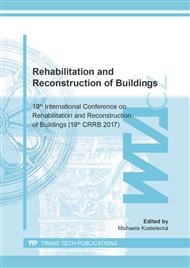[1]
H. Akahane, T. Furuno, H. Miyajima, T. Yoshikawa, S. Yamamoto, Rapid wood silicification in hot spring water: an explanation of silicification of wood during the Earth's history, Sedimentary Geology Vol. 169 (2004) 219 – 228.
DOI: 10.1016/j.sedgeo.2004.06.003
Google Scholar
[2]
M. Brebu, C. Vasile, Thermal degradation of lignin – a review, Cellulose chemistry and technology Vol. 44 (2010) 353-363.
Google Scholar
[3]
J. Daňková, L. Reinprecht, T. Murínová, P. Mec, M. Pánek, L. Plevová, Performance of methyl-tripotassiumsilanol treated wood against swelling in water, decay fungi and moulds, Wood Research Vol. 58 (2013) 511 – 520.
Google Scholar
[4]
D. Horský, L. Reinprecht, Štúdia subfosilného dubového dreva (Studies of subfosil oak wood), VŠLD Zvolen, Zvolen, (1986).
Google Scholar
[5]
J. Jae, G. A. Tompsett, Y. Ch. Lin, T. R. Carlson, J. Shen, T. Zhang, B. Yang, Ch. E. Wyman, W. C. Connera, G. W. Huber, Depolymerization of lignocellulosic biomass to fuel precursors: maximizing carbon efficiency by combining hydrolysis with pyrolysis, Energy and Environmental Science (2010).
DOI: 10.1039/b924621p
Google Scholar
[6]
K. W. Kim, Ch. J. Yoon, P. G. Kim, M. B. Lee, J. H. Lim, Fine structure and X-ray microanalysis of silicified woods from a Tertiary basin Pohang, Korea by scanning electron microscopy, Micron Vol. 40 (2009) 519 – 525.
DOI: 10.1016/j.micron.2009.04.006
Google Scholar
[7]
A. Požgaj, D. Chovanec, S. Kurjatko, M. Babiak, Štruktúra a vlastnosti dreva (Structure and properties of wood), PRÍRODA, Bratislava, (1997).
Google Scholar
[8]
L. Reinprecht, Ochrana dreva (Protection of wood), TU in Zvolen, Zvolen, (2004).
Google Scholar
[9]
L. Reinprecht, T. Grznárik, Silán-drevo (Silan- wood), TU in Zvolen, Zvolen, (2014).
Google Scholar
[10]
F. Simon, F. Marchal, F. Pochon, M. Kutnik, I. La Bayon, The potential of silicone-based formulations to enhance wood properties through industrial treatment for outdoor use, The International Research Group on Wood Protection, Sweden, (2011).
Google Scholar
[11]
W. K. Tang, H. W. Eickner, Effect of inorganic salts on pyrolysis of wood, cellulose and lignin determined by differential thermal analysis, Forest Products Laboratory, Madison, (1968).
Google Scholar
[12]
Information on http://www.tainstruments.com.
Google Scholar


